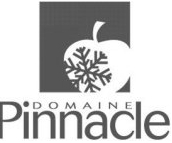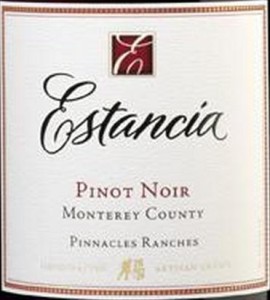 Domaine Pinnacle, Inc., a Canadian-based apple orchard and cidery, filed an intent-to-use application to register a mark in International Class 33 for apple juices and non-alcohol-based beverages on December 30, 2005 (mark pictured right). The description of the mark is as follows: “The mark consists of A drawing of an apple in reverse image with a snowflake on top of the apple above the words Domaine Pinnacle. The word Domaine is on top of Pinnacle.” See Domaine Pinnacle, Serial No. 78783236. Franciscan Vineyards opposed the registration of Pinnacle’s mark, arguing prior use and likelihood of confusion as under Section 2(d) of the Trademark Act, 15 U.S.C. § 1052(d), with respect to Franciscan’s prior registration of the term PINNACLES and PINNACLES RANCHES and in standard character format for “wine” (International Class 33) and “variations thereof.” See Franciscan Vineyards, Inc. v. Domaines Pinnacle, Inc., Opposition No. 91178682 (October 16, 2013) [not precedential].
Domaine Pinnacle, Inc., a Canadian-based apple orchard and cidery, filed an intent-to-use application to register a mark in International Class 33 for apple juices and non-alcohol-based beverages on December 30, 2005 (mark pictured right). The description of the mark is as follows: “The mark consists of A drawing of an apple in reverse image with a snowflake on top of the apple above the words Domaine Pinnacle. The word Domaine is on top of Pinnacle.” See Domaine Pinnacle, Serial No. 78783236. Franciscan Vineyards opposed the registration of Pinnacle’s mark, arguing prior use and likelihood of confusion as under Section 2(d) of the Trademark Act, 15 U.S.C. § 1052(d), with respect to Franciscan’s prior registration of the term PINNACLES and PINNACLES RANCHES and in standard character format for “wine” (International Class 33) and “variations thereof.” See Franciscan Vineyards, Inc. v. Domaines Pinnacle, Inc., Opposition No. 91178682 (October 16, 2013) [not precedential].
Likelihood of Confusion
The Marks
The Board noted that opposer (as plaintiff in the proceeding) bears the burden of establishing there is a “likelihood of confusion by a preponderance of the evidence.” Id. First, the Board reviewed the similarity or dissimilarity of the marks in their entireties with respect to sound, appearance, connotation, and commercial impression. See id. While the Board acknowledged the difference in design between the two marks, the Board also noted that such “minor distinctions” would likely be overlooked by an average consumer and instead be “confuse[d] . . . as originating from the same source, given that they either contain or consist solely of the literal element ‘pinnacle’ or ‘pinnacles.'” Id. In its analysis, the Board noted that the word “Pinnacle” in the applicant’s mark is more likely to be remembered by a consumer for the mere fact that “Pinnacle” appears in larger font size when compared to that of “Domaine.” In addition, the Board notes that words like “Domaine,” or the French word for “estate,” are generally considered to be “disclaimed” matter and are less significant in creating a commercial impression. Thus, in totality, “Pinnacle” was the dominant element in the mark and, similarly, the same holds true for the “PINNACLES RANCHES” mark. Id. Furthermore, the Board found that with respect to connotation and commercial impression, the Board found the terms “PINNACLE” and “PINNACLES” to be highly similar. Thus, the Board found that the marks were similar with respect to sound, appearance, connotation, and commercial impression—one of the du Pont factors weighing in favor of finding a likelihood of confusion.
Fame of the Prior Mark
In likelihood of confusion cases, if fame of the prior mark is found to exist, it plays a dominant role in likelihood of confusion. In this case, opposer argued that the mark “PINNACLES” is famous due to its use for over forty years and pointed to its worldwide sales at wholesale level as well as honors and tributes from leading wine-related publications. The Board found that the opposer’s evidence fell short of establishing fame, as the sales did not specifically break down total U.S. sales and “the few instances of unsolicited media recognition, without more, are insufficient to support opposer’s assertion that its wine sold under the PINNACLES and/or PINNACLES RANCHES marks enjoy wide brand name recognition among consumers.” Id. Therefore, the Board concluded this du Pont factor was neutral.
Third Party Uses
Next, the Board considered the number and nature of similar marks used on similar goods. For the sixth du Pont factor, opposed argued that because the records were absent of third party examples with respect to wine and/or apple-based beverages, its mark was thus strong. The Board noted, however, that evidence of third party uses is usually introduced by the defendant, and not the plaintiff. In this case, since there was no evidence of such use, the Board contended that it could not conclude that the opposer’s marks are therefore strong and therefore worthy of protection. “Furthermore, to the extent, if any, opposer is arguing that its mark is conceptually strong, we disagree, finding that the mark is suggestive for the reasons articulated above in our discussion of the first du Pont factor.” Id. Thus, the Board found this factor to be neutral.
The Trade Channels/Purchasers
The Board identified that the trade channels overlapped in part—the applicant’s channels are wholesalers and retailers and the opposer’s channels are wholesalers and restaurants, as well as retails stores—and thus weighed in favor of likelihood of confusion.
The Goods
The Board’s next, and albeit most imperative, step was to identify the goods in applicant’s application vis-à-vis the goods in opposer’s registrations. In arguing that the goods are related, opposer relied heavily on In re Jacob Demmer KG, 219 USPQ 1199 (TTAB 1983), in which the Board refused to register similar marks for goods classified as wine and apple cider. In its decision in In re Jacob Demmer KG, the Board relied heavily on the dictionary definition of cider, which can be both an alcohol-based and non-alcohol-based beverage, but specifically can be a fermented apple juice with an alcohol by volume percentage “not significantly less” than that of wine. See In re Jacob Demmer KG at 1201. In addition, the Board in In re Jacob Demmer KG relied on the dictionary definition of wine, finding that “the fruit from which cider is made can also be used to make wines and the cider or apple juice itself . . . .” Id. In addition, the opposer introduced evidence from websites that both applicant and opposer are competitors in the Canadian market with respect to wine and ice wine. The Board here, however, noted that each case must stand on its own facts and the Board could thus not rely on the determinations made in In re Jacob Demmer KG to make factual findings in this case, especially considering In re Jacob Demmer KG was an ex parte appeal (and, for inter partes proceeding such as this case, the opposed has the burden of introducing evidence that the goods are related). Additionally, with respect to the Board noted that the evidence was of little probative value because the information pertained to Canadian, and not U.S., entities.
In its analysis, the Board pointed out that it had no evidence that wine and apple juice or “apple-based non-alcoholic beverages” are complementary products, “for example, consumed together at the same meal . . . or that these products are sold in proximity to each other in retail outlets and grocery stores.” Id. Thus, the Board did not find this du Pont factor to be in favor of likelihood of confusion.
The Market Interface Between the Parties
Opposer contended that applicant’s user or intent-to-use the applied-for-mark without the opposer’s consent or permission favors a likelihood of confusion. However, the Board noted that in this case there was neither consent from the opposer nor an agreement between the two parties and thus the Board could not draw a conclusion that the absence of such an agreement draws favor to likelihood of confusion, therefore deeming this du Pont factor neutral.
Conclusion
The Board found that the lack of evidence for showing relatedness of goods outweighed the first, third, and fourth du Pont factors and thus the opposed failed to prove its likelihood of confusion case by a preponderance of the evidence.
Is This Right?
In his blog post, “TTAB Dismisses 2(d) Opposition Due to Lack of Proof That Wine and Apple Beverages Are Related,” trademark attorney John L. Welch contemplates whether the outcome of this decision is proper. Specifically, he ponders whether opposer’s failure to produce evidence of third-party use of the mark and the Board’s refusal to find that the lack of such evidence reinforced the commercial strength of opposer’s mark was wrong. This is a great point and one that should be taken seriously. Perhaps, due to patrolling the marketplace for use of its mark and successful cease and desist letters, third party use was simply nonexistent, as Franciscan Vineyards contends. Why should companies be penalized for such due diligence? Or, perhaps what the Administrative Trademark Judge was attempting to say is the Board needed evidence, such as prior pursuits to remove third party uses (e.g., cease and desist letters). This is unclear—but I do agree with Mr. Welch in that a company should not be hindered by its inability to produce evidence of third party use, especially if none exists.
Furthermore, it is difficult not to wonder how different the outcome may have been if the products were apple juice and dealcoholized wine, or even alcohol-based cider and wine. But that being said, this opinion reverts my thinking back to the TTAB’s recent decision from Joel Gott Wines v. Rehoboth Von Gott where the Board found a likelihood of confusion existed between a mark for wine and a mark for water. See From Water to Wine (Trademark): Joel Gott Wines v. Rehoboth Von Gott. Albeit, disregarding that each case must “stand on its own facts” and discounting the obviously different mark names and types in Gott and Pinnacle, it is still curious that a likelihood of confusion was found for water and wine, but  not non-alcohol-based apple juice and wine.
not non-alcohol-based apple juice and wine.
That being said, if one reviews the label of a bottle of PINNACLES RANCHES, it is worth noting that the actual brand name of the wine appears to be ESTANCIA, as classified on its TTB Certificate of Label Approval here. While this fact does not discount the above discussion nor the availability of a trademark for PINNACLES RANCHES, it is worth noting that on both the physical application and the label itself the term PINNACLES seems to be secondary to ESTANCIA.
Domaine Pinnacle photo property of the United States Patent and Trademark Office, Serial No. 78783236; Estancia Pinnacles Ranches photo property of Wine-searcher.com.
For more information on wine or alcohol law, trademark, or labeling, please contact Lindsey Zahn.
DISCLAIMER: This blog post is for general information purposes only, is not intended to constitute legal advice, and no attorney-client relationship results. Please consult your own attorney for legal advice.